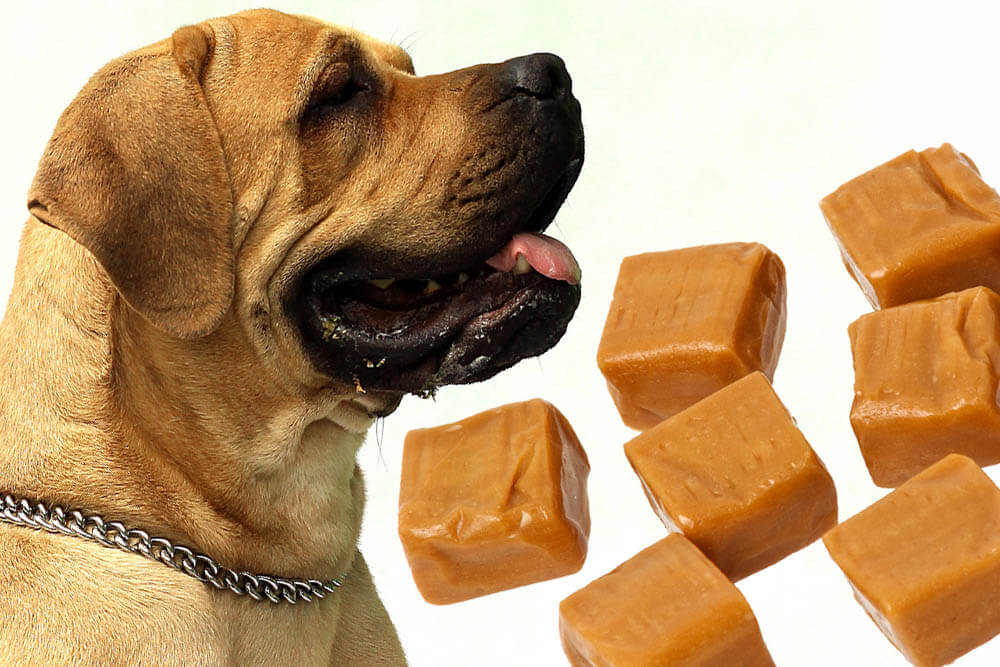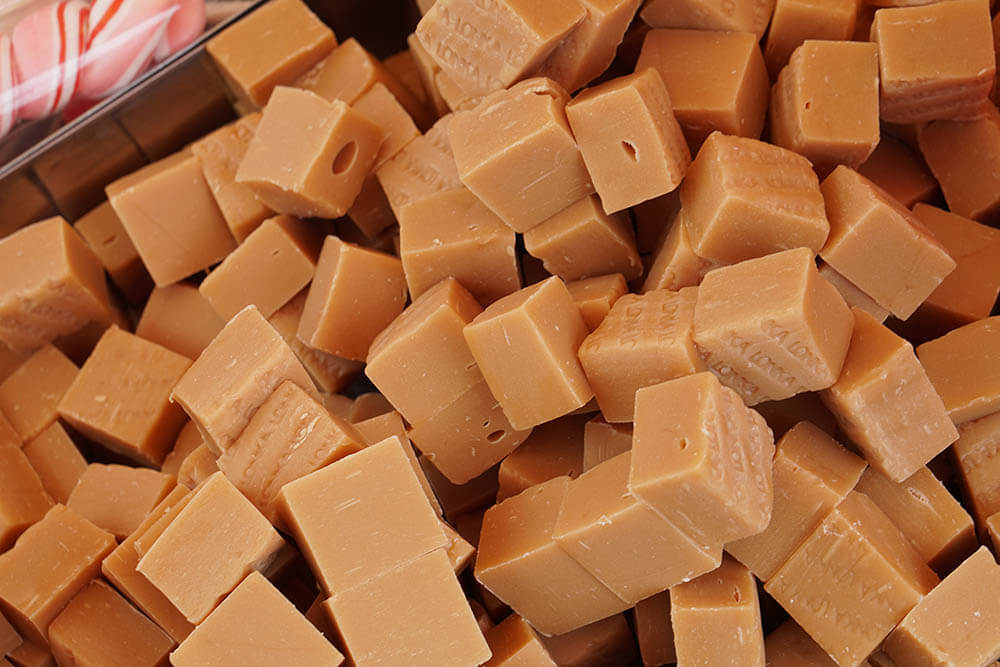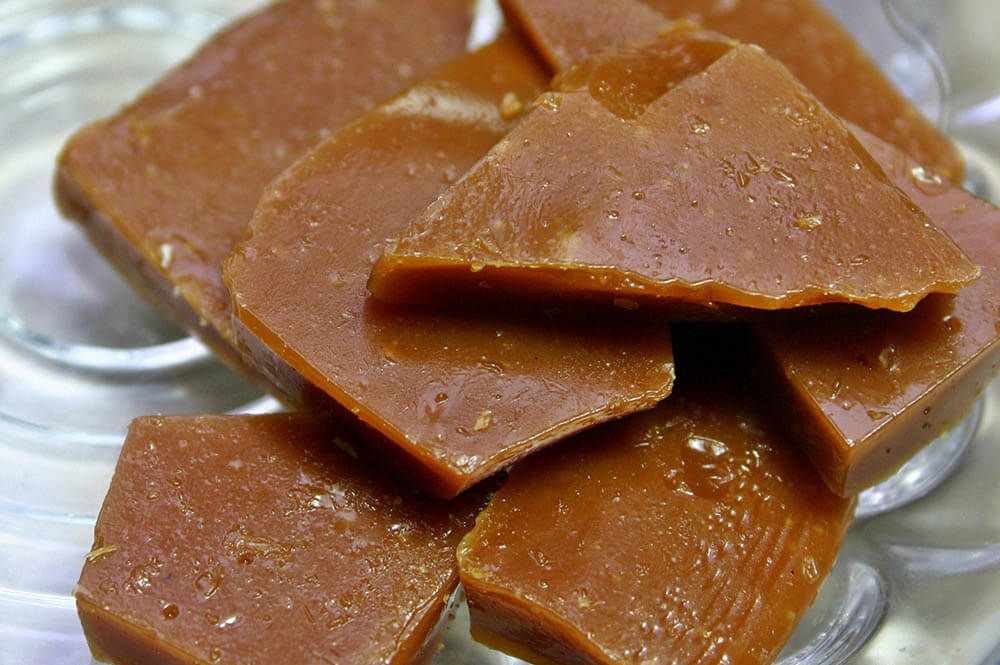It’s often a bad idea to feed dogs sweets meant for humans. For example, chocolate, marshmallows, and cotton candy can all kill a dog.
What about caramel? Surely something so sumptuous won’t hurt your pet?
Unfortunately, no, dogs shouldn’t be fed caramel.
True, caramel isn’t toxic to dogs, so one or two bites won’t cause any serious, lasting damage. But this sweet can still cause your pet discomfort. If eaten frequently, it can make them ill.
And then there’s the type of caramel that contains an artificial sweetener called xylitol, which can cause deadly toxicity in your dog.
So long story short: caramel is unhealthy for dogs. Don’t feed dogs caramel!
If you’d like a more detailed discussion of why caramel is bad for dogs, read on!

What is caramel?
Caramel is a type of confection known for its delectable flavor and iconic orange-brown hue. It is created via the slow heating of sugar or syrup (which is also made of sugar).
Caramel is the major component of various candies and desserts – all of them bad for dogs.
Sugar: why caramel is bad for dogs
Generally speaking, sugar is bad for dogs. And since caramel is just sugar in a different form, caramel is also bad for dogs.
A small piece of caramel is unlikely to cause your dog great harm, but it may still make them ill. Eating the sweet often or in abundance can result in bigger, long-term problems.
Below are some of the issues that can occur if you feed dogs caramel:
Digestive issues
Dogs obtain their sugar from the carbohydrates found in high-quality dog food as well as dog-friendly vegetables and fruits. Sugar from human-made sources (such as candy) is an unnecessary excess.
Excess sugar doesn’t always agree with the ultra-sensitive canine digestive system. So if your pet ingests caramel, they may experience an upset stomach, nausea, vomiting, diarrhea, or gas. If these symptoms grow severe, you’ll need the help of a vet.
Consuming surplus sugar can make a dog gain unhealthy weight which, in turn, can culminate in obesity.
Obesity significantly lowers a dog’s quality of life. The extra weight impacts the bones and joints, increasing the risk of joint pain and osteoporosis. Such issues reduce a dog’s mobility, discouraging the exercise that’s required for weight loss.
Obesity also raises the risk of early death, as the condition is linked to many problems, including diabetes, heart disease, hypertension, various cancers, urinary bladder stones, and increased vulnerability to heatstroke.
Don’t feed dogs caramel if you want them to maintain an ideal weight.

High blood sugar levels
Eating sugary food raises your dog’s blood sugar levels, which isn’t so bad if it only happens occasionally.
However, frequent caramel consumption prevents those levels from going down. As a result, a dog may suffer from dehydration, extreme thirst, depression, lower energy levels, seizures, or even a coma.
If worse comes to worst, a dog may develop kidney disease, heart disease, stroke, and possibly even diabetes.
Pancreatitis
As previously stated, sugar consumption raises your dog’s blood sugar levels. Those levels return to normal thanks to the actions of an organ known as the pancreas.
The pancreas produces insulin, a hormone that lowers elevated blood sugar levels by breaking down sugar in the bloodstream. If your dog eats caramel regularly, the pancreas is forced to work extra hard to produce more insulin. An overworked pancreas can become damaged or inflamed, resulting in a condition known as pancreatitis.
The consequences of untreated pancreatitis are usually fatal. Therefore, it’s important to monitor a sugar-loving dog for pancreatitis symptoms, which include diarrhea, constant vomiting, abdominal pain, abdominal distention, poor appetite, lethargy, weakness, fever, and a hunched back.
Sugar addiction
Eating sugary treats such as caramel can cause sugar addiction in a dog. Addiction, in turn, reduces their interest in a healthy diet.
If your pet avoids vet-approved, nutrient-dense food because they’d rather eat caramel, their health will suffer. It’ll take a fur parent lots of work to get a dog interested in healthy foods again.
Sugar rush
Consuming caramel can give your dog a sugar rush, whose symptoms include increased thirst, inappropriate and/or frequent urination, fatigue, and lack of focus. It may even cause restlessness and hyperactivity, leading to behavioral problems such as excessive chewing.
Tooth decay
When a dog eats caramel, the bacteria in their mouth produce acid to break down sugar. The more caramel your dog eats, the more acid these bacteria produce.
Elevated acidity levels in the oral cavity are conducive to the erosion of the enamel (the tooth’s hard outer layer). Worn enamel makes a dog exceptionally prone to cavities, tooth infection, and tooth loss.

Xylitol: why caramel is toxic to dogs
Not all caramel contains sugar. For those among us trying to lose weight, we can enjoy the sugar-free variety that uses an artificial sweetener called xylitol.
Here’s the problem: xylitol is highly toxic to dogs.
When a dog eats caramel containing xylitol, their blood sugar levels plunge. This can lead to liver damage, liver failure, and even death.
A dog that’s ingested xylitol may also experience an upset stomach, shivering, seizures, weakness, exhaustion, unconsciousness, and a coma.
These issues typically manifest around 30 minutes after xylitol ingestion. However, some dogs can go as long as 24 hours without displaying any symptoms. Therefore, dog owners shouldn’t assume a pet that’s consumed xylitol is fine just because they haven’t experienced any problems yet.
Your dog’s size, age, sex, and breed don’t matter; any amount of xylitol can harm them. So if your pooch swallows even a tiny piece of xylitol-containing caramel, seek a veterinarian’s aid immediately.
Keep your dog safe: never share artificially sweetened caramel with them!

Every pet parent should take measures to ensure their beloved fur babies are safe from the problems caused by caramel ingestion.
Get help from a veterinarian
Don’t worry too much if your dog eats sugary caramel. Nevertheless, you should at least contact a vet for advice about what to do next, especially if your dog exhibits symptoms of health problems. For example, if your dog starts vomiting or leaking diarrhea, a vet can inform you about the steps you can take to relieve such issues and ensure they don’t repeat. Severe and/or persistent symptoms will require a trip to the vet.
If your dog ingests caramel that contains xylitol, you should bring your dog to the vet immediately. Xylitol poisoning is a serious concern requiring emergency treatment by a professional. If for any reason a vet is unavailable, you can contact the Pet Poison Helpline at (855) 764-7661 (this is only available in North America, however).
Be prepared
You should know whom to contact in the case of an emergency. Therefore, everyone at home should have the contact information of their area’s best vet clinics on their smartphone.
You should also write down each clinic’s address and phone number on a sheet of paper, then ensure said sheet is visible in any of your house’s high-traffic areas. You can, for example, stick the paper to the fridge door.
Make sure you keep a record of the aforementioned Pet Poison Helpline’s phone number, as well!
Hide your caramel
Make sure your dog doesn’t have access to caramel and other sugary foods. Hide them in places where they can’t be smelled, seen, or taken by your pet, such as the fridge or the cupboards above the kitchen counter. If you have a smarty-pants dog who can open fridge doors and climb counters, lock the kitchen door before you step out of the house.
Read labels
Always check food labels for canine toxins such as xylitol. Any food containing xylitol should be exceptionally well-hidden from your pet.
Both food and non-food items can contain xylitol. Examples include toothpaste, mouthwash, over-the-counter vitamins, drink powders, barbecue sauce, ketchup, peanut butter, and cereals.
Don’t feed dogs caramel-rich food
Any food that uses caramel as an ingredient isn’t healthy for dogs.
Most desserts are rich in sugar and other substances that can make a dog ill. If a dessert is mixed with caramel, that’s more sugar than your dog can handle. So don’t give dogs caramel ice cream, caramel fudge, caramel cake, and the like.
As salt can cause dehydration and salt poisoning, never give dogs salted caramel or any other salty food.
Pastries such as waffles aren’t necessarily bad in small quantities. Too much too often, however, is fattening, especially if they contain caramel.
Caramel syrup, caramel dip, and caramel sauce are supper fattening to dogs; say no to them.
Hard caramel candies, such as caramel lollipops, can cause tooth damage, tooth loss, and choking.
In short, refrain from giving your dog any caramel-containing food.

Conclusion
Because caramel is either unhealthy or toxic to dogs, you should avoid feeding your pet caramel in any form. So keep your caramel out of sight and reach, and make sure to contact a vet if your pet consumes any.
